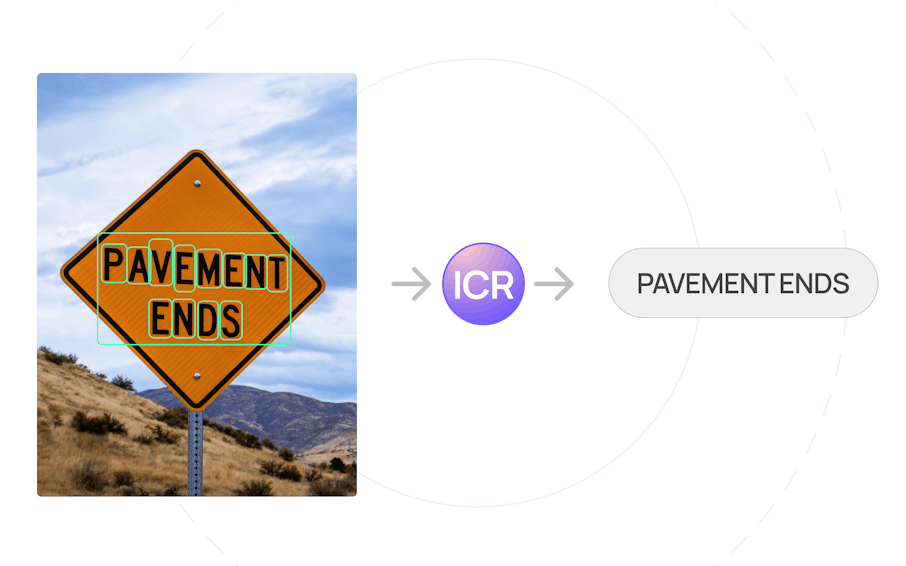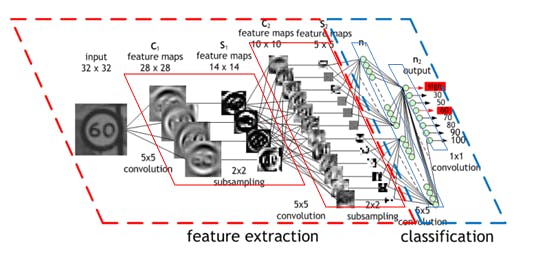Contents
Core Concepts of ICR
ICR Technology: How Does it Work?
ML Algorithms Enhancing ICR
Tools and Frameworks for ICR
Applications of ICR
Intelligent Character Recognition (ICR): Key Takeaways
Encord Blog
Intelligent Character Recognition: Process, Tools and Applications

Intelligent Character Recognition (ICR) applications are developed to recognize and digitize handwritten or machine-printed characters from images or video streams. ICR can interpret complex handwriting styles within documents and forms using machine learning (ML) algorithms such as convolutional neural networks (CNNs) and recurrent neural networks (RNNs).
ICR applications are used for identity verification, healthcare patient form digitization, handwritten label recognition logistics, financial document processing, and digitizing written responses in educational settings. They generally improve document processing across various industries (e.g., automating manual tasks such as check verification).
In this article, we will learn what ICR is, its importance in the data-driven industry, its evolution, core concepts, and the ML algorithm that powers its capabilities. We will also cover its technical aspects and the algorithm it leverages to make itself smart. This article will enable you to get a deeper understanding of ICR.
Let’s get started.
Core Concepts of ICR
Before learning more, it's crucial to understand the foundational technology behind Intelligent Character Recognition (ICR)—Optical Character Recognition (OCR). OCR converts printed text from documents such as forms and receipts into digitally readable text. This process transforms a physical document into a digital format.
Why is OCR Important?
Managing physical documents like forms, invoices, and contracts in business environments is space-consuming and time-intensive. OCR technology addresses these challenges by digitizing printed documents for easier editing, searching, and storage. This is beneficial for automating data entry and improving workflows.
OCR:Key Features of OCR
- Recognizes text from various sources, including scanned documents and image-only PDFs.
- Converts images of text into editable formats, facilitating access and modification without manual retyping.
- Uses hardware (scanners) and software to transform printed text into machine-readable text.
While OCR offers numerous benefits, it has limitations when dealing with poorly handwritten text. ICR was developed as an advanced form of OCR to address this challenge, using ML and natural language processing (NLP) to interpret handwritten characters more accurately.
In the following section, we will discuss some of ICR's features and capabilities. This will give you a better understanding of ICR's usefulness over OCR.
ICR: Key Features
Knowing the key features and capabilities will allow you to understand how ICR can be incorporated into your workflow. Here are 12 key features to better understand ICR:
- Handwriting Recognition: ICR can recognize and interpret handwritten text, including various styles and fonts.
- Data Extraction: Beyond text, ICR can extract checkboxes, tick marks, and other structured data elements from documents.
- Multilingual Support: Supports multiple languages, improving its utility in global applications.
- Improved Accessibility: ICR makes handwritten documents searchable, editable, and retrievable, enhancing data accessibility and usability.
- Self-Learning: By leveraging machine learning, ICR continuously learns and improves its accuracy over time, adapting to new handwriting styles and formats.
- Workflow Automation: Facilitates the automation of document processing workflows, which reduces manual data entry errors and improves operational efficiency.
ICR Integration Capabilities
- Document Management Systems (DMS): ICR seamlessly integrates with DMS, streamlining document processing and data entry workflows.
- Robotic Process Automation (RPA): ICR can be combined with RPA tools to automate data extraction tasks, reducing manual work and improving efficiency.
- API Integration: ICR systems offer API support (e.g., REST, SOAP) and compatible data formats (e.g., JSON, XML) for easy integration with other applications.
ICR Data Types: Types of Data ICR Can Process
We have already discussed the capabilities of ICR for processing handwritten documents. Here are examples of the other types of documents that ICR can process:
- Scanned Documents: Recognizes text from paper documents converted to digital formats.
- Digital Images and PDFs: Extracts text from digital images and PDF files, whether originally digital or scanned.
- Structured Data Files: Efficiently processes structured data files like XML, enhancing data usability in various applications. For services like Globeia, a document verification provider, ICR's ability to accurately process scanned documents and digital images is critical for efficient verification processes.
Benefits of ICR Technology
- Automation and Efficiency: By automating manual data entry tasks, ICR streamlines operations, increases processing speed, and allows employees to focus on higher-value tasks.
- Scalability and Cost Savings: ICR can handle large volumes of data, scaling with business growth while reducing manual labor costs.
- Improved Decision-Making: With accurate and easily accessible data, ICR enables informed decision-making and enhances customer experiences.
- Improved Data Quality: ICR accurately recognizes handwritten text and verifies data, reducing errors and improving overall data quality.
In the following sections, we will explore the inner workings of ICR and the key technologies it leverages, such as computer vision (CV), NLP, and deep learning. We will also discuss how these technologies enable ICR to recognize and interpret handwritten text intelligently.
ICR Technology: How Does it Work?
The workings of ICR can be broken down into seven steps, which lay the foundation for the integration of advanced technologies, such as machine learning algorithms:

The diagram shows how ICR works using CNN and RNN
- Image Capture: Handwritten text is digitized using scanners, cameras, or other digital devices.
- Preprocessing: This step cleans the image, removes noise, and corrects lighting to prepare it for analysis.
- Binarization/Segmentation: The image is segmented into individual characters or words, setting the stage for detailed analysis.
- Feature Extraction: Critical features such as the shape and size of each character are identified to facilitate recognition.
- Pattern Recognition: Here, advanced machine learning algorithms, including neural networks, classify features into their corresponding characters.
- Context Analysis: The system analyzes all the words or sentences to understand their meaning and context.
- Post-processing: Finally, the recognized text is converted into a digital format, ready for use in computers and databases.
Let’s learn more about the ML algorithms that power ICR capabilities.
ML Algorithms Enhancing ICR
ICR has undergone a remarkable transformation because of the advancements in ML algorithms. Previously, ICR relied on rule-based methods to decipher handwritten text, facing challenges in handling diverse writing styles. However, with the emergence of ML, ICR has vastly improved in accuracy and efficiency.
Neural Networks
Inspired by the human brain, neural networks (NN) excel at tasks like object detection, learning from extensive datasets of labeled handwritten text. However, their true potential is unlocked when dealing with complex data, provided there is enough data to learn from.

This image explains the working of neural networks through forward and backward propagation
Convolutional Neural Network
Convolutional neural networks (CNNs) have emerged as a prominent architecture for ICR to address the limitations of traditional neural networks. CNNs specialize in processing image data by identifying local features, edges, and patterns through convolutional layers. This enables CNNs to effectively recognize handwritten characters, even in the presence of noise or variations in writing style, giving ICR an edge over traditional OCR.

An overview of how the different layers of CNN works and the patterns they capture
Vision Transformers
Another notable advancement in ICR is using vision transformers (ViTs), which apply the transformer architecture, originally developed for natural language processing, to image data. ViTs use self-attention mechanisms to capture long-range dependencies and context within images, enabling them to understand the relationships between characters and words in handwritten documents.

An overview of how transformers work and the patterns they capture
The idea behind both CNN and ViT is to capture the details of the textual images provided. ICR systems can handle diverse handwriting styles and fonts by integrating these sophisticated ML algorithms.
This continually improves the accuracy of ICR’s pattern recognition with more data. This has also revolutionized data entry automation, document processing, and other tasks reliant on extracting information from handwritten sources.
These technologies have made ICR systems more accurate, versatile, and adaptable, benefiting businesses and organizations across various sectors.
The next section will discuss implementing ICR in your workflow to harness its potential.
Tools and Frameworks for ICR
This section will focus on the tools and frameworks for implementing ICR in our workflow.
Overview of Popular ICR Software and Libraries
Let’s start this section with open-sourced tools like Tesseract OCR, a versatile and widely used open-source engine ideal for recognizing handwritten and printed text. Following that, we will briefly discuss commercial tools like ABBYY FineReader as well.
Open-source tools
- Tesseract OCR: This is a versatile, widely-used open-source engine suitable for recognizing both handwritten and printed text. It is particularly beginner-friendly and supports multiple languages.
- Kraken: A Python-based OCR engine, Kraken is designed for modern OCR tasks, offering cleaner interfaces and better documentation than its predecessors. It supports right-to-left languages and provides advanced model-handling capabilities.
- Ocropy: Known for its fundamental OCR processes, Ocropy offers a suite of command-line tools for various OCR tasks, though it is less maintained currently.
Commercial
- ABBYY FlexiCapture: This platform offers advanced data capture and document processing capabilities that are suitable for both on-premises and cloud deployment. It features robust document classification and data extraction technologies.
- ReadSoft: Part of the ReadSoft Capture Framework, this tool enhances document workflow efficiency, particularly in invoice processing, through its learning OCR capabilities.
- Kofax: Known for its comprehensive automation solutions, Kofax combines OCR with document scanning and validation functionalities to streamline data processing.
Deployment options
- Cloud-based Platforms: Tools like ABBYY Vantage, Google Cloud Vision AI, Microsoft Azure AI Vision, and Amazon Textract offer scalable, cloud-based OCR services with extensive model marketplaces and integration capabilities.
- On-premise Platforms: Solutions like ABBYY FlexiCapture and Sunshine OCR Software provide secure, on-premise deployment options for organizations prioritizing data security.
Integration with existing DMS
- ABBYY Vantage: ABBYY's cloud-based data capture "marketplace" enables seamless integration with various Document Management Systems.
Programming Languages and Frameworks for Building ICR Systems
Now, let’s talk about the programming language and framework that can help you develop a custom ICR.
- Python: With its simplicity and extensive library support, Python is a top choice for developing ICR systems. Libraries like EasyOCR are specifically built using Python.
- TensorFlow and PyTorch: These frameworks are essential for building deep learning models that enhance ICR capabilities. TensorFlow is known for its robust, scalable deep learning model deployment, while PyTorch offers flexibility in model experimentation and development (but is fast supporting a vast model-serving ecosystem).
Integrating ICR with Other Technologies
- NLP Integration: Combining ICR with NLP enables organizations to extract and analyze insights from handwritten documents efficiently, which is applicable to the finance and healthcare sectors.
- RPA Integration: By integrating ICR with RPA, organizations can automate repetitive document processing tasks, enhancing efficiency and accuracy across various operational areas.
Applications of ICR
ICR technology finds significant applications across various sectors, enhancing data management and operational efficiency through automation and accurate data extraction.
Healthcare
In healthcare, ICR facilitates digitizing patient information by converting handwritten medical records, prescriptions, and forms into digital formats. This automation helps create more accurate clinical documentation and supports decision-making processes.
Additionally, when integrated with NLP, ICR can extract and analyze insights from unstructured handwritten notes to improve patient care and research.
Insurance
ICR speeds up claims processing by digitizing handwritten policy information. It also plays a crucial role in fraud detection by analyzing handwritten signatures and other personal identifiers, thereby enhancing security and trust.
Traffic Management
ICR automates the processing of handwritten citations, extracting critical vehicle and driver information. This capability supports more efficient traffic enforcement and reduces manual errors in data entry, resulting in safer and more regulated roadways.
Legal Analysis
ICR helps legal professionals by automating the extraction of information from handwritten legal documents and notes. By converting these into searchable digital formats, ICR enhances research efficiency and supports more effective case preparation and management.
Government Agencies
ICR streamlines data entry and document processing, particularly for forms that require manual handling. Integration with RPA technologies further enhances this process, automating repetitive tasks and significantly improving the timeliness and accuracy of public data management.
These applications underscore the versatility and transformative potential of ICR technology across different industries, offering substantial improvements in process efficiency and data accuracy.
Intelligent Character Recognition (ICR): Key Takeaways
ICR makes handwritten documents easier to find, edit, and use. It handles paperwork automatically, helping businesses work faster and with fewer mistakes. It gets smarter over time by using fancy tech like machine learning, natural language processing, and robotic process automation.
Advancements in ML and automation will shape future trends in ICR. These trends include enhancements in deep learning OCR for deciphering complex characters and unclear handwriting. They will also benefit from multilingual support for global needs and integration with AI and automation technologies to refine document processing workflows.
Additionally, the evolution of Intelligent Document Processing (IDP) will see ICR integration to automate processing and enhance document analysis while human oversight ensures accuracy in critical tasks. Scalable cloud solutions will handle large document volumes efficiently, and industry-specific solutions tailored to sectors like healthcare and finance will emerge.
Explore our products
- ICR works by capturing handwritten text via images and processing them through various steps. These involve pre-processing, character segmentation, feature extraction, pattern recognition, context Analysis, and post processing. The entire process employs machine learning algorithms to convert handwritten characters into digital text.
- The ICR automates by converting or transforming handwritten documents into editable and searchable digital formats. This enables data accessibility and reduces the manual labor linked with data entry, thereby improving the efficiency and accuracy of document processing.
- ICR is designed for handwritten text. ICR uses advanced ML techniques to learn from new data. The traditional OCR on the other hand is more suited to printed text. Companies may opt for ICR over OCR when dealing with a substantial volume of handwritten documents, as ICR can adapt to various handwriting styles and enhance accuracy over time.
- Yes, ICR systems can effectively manage handwritten documents from various sources and with differing levels of legibility. They utilize machine learning to adjust to different handwriting styles and can refine their recognition accuracy with increased document processing.
- Businesses may encounter challenges such as compatibility with existing IT infrastructure, the necessity for substantial training data to achieve high accuracy, and the complexities of integrating with current document management systems not initially designed for ICR inputs.
- ICR integrates with other business systems like CRM or digital archives by converting handwritten documents into digital formats that are easily searchable and storable. This integration usually involves APIs or middleware facilitating data transfer between ICR systems and other business applications, thus enhancing data accessibility and workflow automation.
- ICR accuracy rates can vary, depending on the handwriting complexity, document quality, and language specifics. Generally, ICR systems achieve higher accuracy with clear, simple handwriting and common languages for which ample training data is available. Accuracy rates typically range from 80% to 95% under optimal conditions.
- Implementing ICR can strengthen data security by reducing human interaction during data entry. This minimizes the risk of data leakage or errors. However, robust security measures are crucial to safeguard the processed data, particularly when handling sensitive or personal information.




